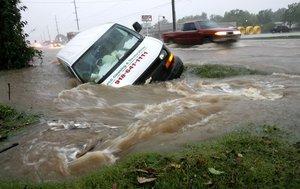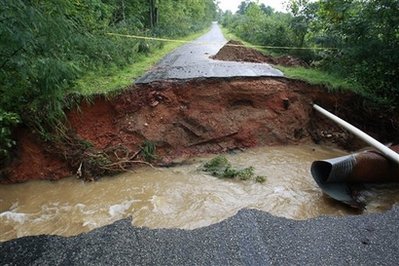
| Check River, Creek, and Lake Levels Here | Ongoing Decision Support Information Here | ||
| 24-hr rainfall ending 7am this morning | Current Rainfall Map | ||
|
|
|||
Flood Safety Information
* Monitor the NOAA Weather Radio, or your favorite news source for vital weather related information.
* If flooding occurs, get to higher ground. Get out of areas subject to flooding. This includes dips, low spots, drainage ditches, canyons, washes etc.
* Avoid areas already flooded, especially if the water is flowing fast. Do not attempt to cross flowing streams. Turn Around Don't Drown™
* Road beds may be washed out under flood waters. NEVER drive through flooded roadways - you do not know the condition of the road under the water. Turn Around Don't Drown™
* Do not camp or park your vehicle along streams and washes, particularly during threatening conditions. Move to higher ground if heavy rain or rising water occurs. Creeks and streams can rise very rapidly during heavy rainfall.
* Be especially cautious at night when it is harder to recognize flood dangers.
* If you must evacuate your home, secure your home and if possible, turn off utilities at the main switches or valves if instructed to do so. Disconnect electrical appliances. Do not touch electrical equipment if you are wet or standing in water.
* Do not walk through moving water. Six inches of moving water can make you fall. If you have to walk in water, walk where the water is not moving. Use a stick to check the firmness of the ground in front of you.
* Do not drive into flooded areas. If floodwaters rise around your car, abandon the car and move to higher ground if you can do so safely. You and the vehicle can be quickly swept away.
* Six inches of water will reach the bottom of most passenger cars causing loss of control and possible stalling.
* A foot of water will float many vehicles.
* Two feet of rushing water can carry away most vehicles including sport utility vehicles (SUV’s) and pick-ups.
Play it smart, play it safe. Whether driving or walking, any time you come to a flooded road, TURN AROUND, DON'T DROWN!
Floodwater Safety
Use caution when dealing with flood waters. Flood waters may contain snakes and insects; sharp objects and debris; and oil, gasoline, industrial waste, or raw sewage.
To avoid illness and injury from floodwaters, the Oklahoma State Dept. of Health suggests the following:
* Keep children and pets from playing in flood water.
* Clean all items touched by floodwaters, including children’s toys. Use one cup of household bleach in five gallons of water.
* Throw away items that cannot be washed such as mattresses, stuffed animals, baby toys, and wood cutting boards, as well as food that may have come into contact with flood waters.
* Wash hands often with soap and clean water or use an alcohol-based sanitizer.
* Seek immediate attention if you become injured or ill.
* To protect your family and yourself, avoid floodwaters if possible.
Additional Flood Safety Information from the NWS
What Is Turn Around Don't Drown™ (TADD)?
TADD is a National Weather Service campaign to warn people of the hazards of walking or driving a vehicle through flood waters. Several counties in Eastern Oklahoma have Turn Around Don't Drown signs posted at locations where flash flooding often leads to water over the roads.
These TADD Warning Signs are compliant with the Federal Highway Administration's regulations and can be produced and deployed as an official road sign. If your community would like more information on purchasing these signs, contact the Service Hydrologist at the NWS Tulsa office. Civic groups may consider donating or raising money to give to their local community officials for purchase of these TADD signs.
Why is Turn Around Don't Drown™ So Important?
Each year, more deaths occur due to flooding than from any other severe weather related hazard. The Centers for Disease Control report that over half of all flood-related drownings occur when a vehicle is driven into hazardous flood water. The next highest percentage of flood-related deaths is due to walking into or ear flood waters.Why? The main reason is people underestimate the force and power of water. Many of the deaths occur in automobiles as they are swept downstream. Of these drownings, many are preventable, but too many people continue to drive around the barriers that warn you the road is flooded.
What Can I Do to Avoid Getting Caught is This Situation?
Most flood-related deaths and injuries could be avoided if people who come upon areas covered with water followed this simple advice: Turn Around Don't Drown™.
The reason that so many people drown during flooding is because few of them realize the incredible power of water. A mere six inches of fast-moving flood water can knock over an adult. It takes only two feet of rushing water to carry away most vehicles. This includes pickups and SUVs.

Image courtesy of the Tulsa World
If you come to an area that is covered with water, you will not know the depth of the water or the condition of the ground under the water. This is especially true at night, when your vision is more limited.

AP Photo Dave Martin
Play it smart, play it safe. Whether driving or walking, any time you come to a flooded road, TURN AROUND, DON'T DROWN!
TADD Poster Contest
The Oklahoma Floodplain Managers Association also promotes TADD education and outreach. The organization hosts a TADD poster contest for 4th Grade students and has additional TADD resources available on their website.
For ongoing information on the threat for heavy rain, flash flooding, and other severe weather, visit the NWS Tulsa Decision Support Page.
Additional information on ongoing and forecast River Flooding, please visit the NWS Tulsa Rivers & AHPS page.
|
|
|
|